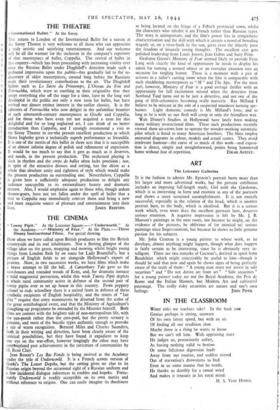THE CINEMA
" Tawny Pipit." At the Leicester Square.—" Underworld." At the Academy.—,, Ministry of Fear." At the Plaza.—Three Disney Instructional Films. For special showing.
How often we have called upon British producers to film the British countryside and its real inhabitants. Not a fleeting glimpse of the village idiot on the green, mopping and mowing whilst bright young things from London flash by en route for Lady Bountiful's, but a picture of English fields to set alongside Hollywood's export of prairies. Now, in two successive weeks, we have films which make a brave attempt to fill the bill. A Canterbury Tale gave us the oast-houses and rounded woods of Kent, and, for dramatic menace a mild magisterial perversion, whilst this week Tawny Pipit depicts a whole rural community active in defence of the second pair of tawny pipits ever to set up house in this country. From peppery colonel to rude schoolboy there is a. united front in defence of these symbolic recipients of English hospitality, and the tenets of "fair play" require that army manoeuvres be diverted from the scene of the great ornithological event, and that the Ministry of Agriculture's ploughing-up programme be amended by the Minister himself. Both films are content with the brighter side of non-metropolitan life, with the sun-porch rather than the- cess-pool, but the pretty scenery is genuine, and most of the bucolic types authentic enough to provoke a stir of warm recognition. Bernard Miles and Charles Saunders, both in their writing and direction, have been dearly aware of the satirical possibilities, but they have found it expedient to keep one eye on the war-effort, however longingly the other may have contemplated past achievements in the caricature of communities by M. Reni Clair.
Jean Renoir's *Les Has Ponds is being revived at the Academy under -the title of Underworld. It is a French screen version of Gorki's The Lower Depths, but the setting gives no due to its Russian origin beyond the occasional sight of a Russian uniform and a few incidental dialogue references to roubles and kopeks. Fortu- nately Underworld is readily acceptible on its own merits and without reference to origins. One can easily imagine its dosshouse as being. located on the fringe of a French provincial town, whilst the characters who inhabit it are French rather than Russian types. The story is unimportant, and the film's power lies in sympathetic characterisation and the skill with which it creates a mood of brooding tragedy or, on a river-bank in the sun, gives even the abjectly poor the freedom of leisurely roving thoughts. The excellent cast gets polished leadership from Louis Jouvet, Jean Gabin and Suzy Prim. Grahame Green's Ministry of Fear seemed likely to provide Fritz Lang with exactly the kind of opportunity he needs to display his talent for turning a normal object or an everyday situation into an occasion for tingling horror. There is a moment with a pair of scissors in a tailor's cutting room when the film is comparable with such shuddering masterpieces as " M " and The Spy. For the most part, however, Ministry of Fear is a good average thriller with an opportunity for full excitement missed when the detective from . Scotland Yard turns out to be just a detective, and not one of the gang of fifth-columnists becoming really masterly. Ray Milland I believe to be miscast in the role of a suspected murderer turning spy- hunter. Light domestic comedy is Mr. Milland's forte, and so long as he is with us our flesh will creep in only the friendliest way.
Walt Disney's Studios in Hollywood have lately been making many military instructional films. Three such productions recently viewed show air-crews how to operate the wonder-working automatic pilot which is fitted to many American bombers. The films employ animated diagrams in colour, models and actual scenes. They avoid irrelevant humour—the curse of so much of this work—and exposi- tion is direct, simple and straightforward, points being hammered


























 Previous page
Previous page